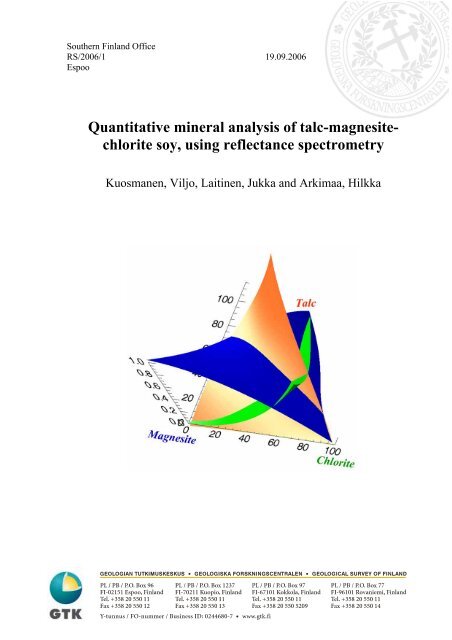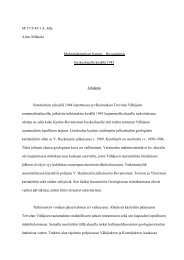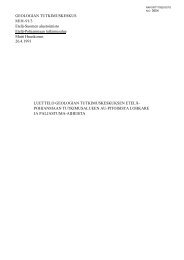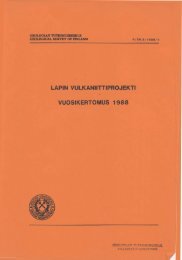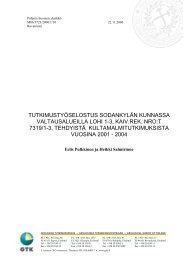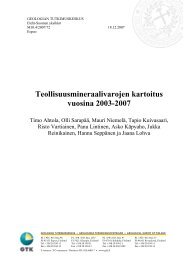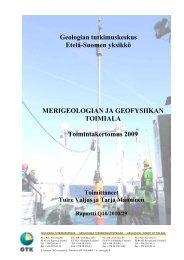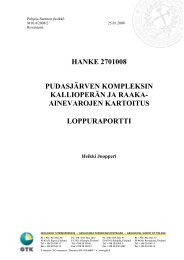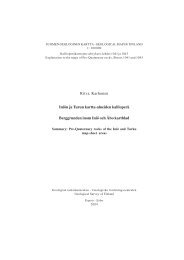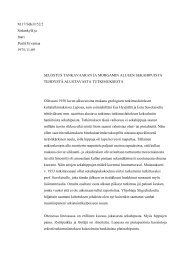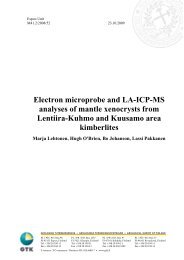Quantitative mineral analysis of talc-magnesite ... - Arkisto.gsf.fi
Quantitative mineral analysis of talc-magnesite ... - Arkisto.gsf.fi
Quantitative mineral analysis of talc-magnesite ... - Arkisto.gsf.fi
Create successful ePaper yourself
Turn your PDF publications into a flip-book with our unique Google optimized e-Paper software.
Southern Finland Of<strong>fi</strong>ceRS/2006/1 19.09.2006Espoo<strong>Quantitative</strong> <strong>mineral</strong> <strong>analysis</strong> <strong>of</strong> <strong>talc</strong>-<strong>magnesite</strong>chloritesoy, using reflectance spectrometryKuosmanen, Viljo, Laitinen, Jukka and Arkimaa, Hilkka
GEOLOGICAL SURVEY OF FINLANDDOCUMENTATION PAGEDate / Rec. no.19.09.2006AuthorsKuosmanen, Viljo, Laitinen, Jukka and Arkimaa,HilkkaType <strong>of</strong> reportArchive ReportCommissioned byTitle <strong>of</strong> report<strong>Quantitative</strong> <strong>mineral</strong> <strong>analysis</strong> <strong>of</strong> <strong>talc</strong>-<strong>magnesite</strong>-chlorite soy, using reflectance spectrometryAbstract<strong>Quantitative</strong> remote detection <strong>of</strong> different <strong>mineral</strong> materials is today an important issue. It can improve identi<strong>fi</strong>cation<strong>of</strong> materials and speed up processes. The need for such techniques exists especially in the mining industry and<strong>mineral</strong> exploration sectors.This work aims to develop the remote sensing method towards quantitative estimation <strong>of</strong> target <strong>mineral</strong>s in realtime. The target <strong>of</strong> this case study is drilling soy from the Lahnaslampi <strong>talc</strong> mine in Sotkamo. The main components<strong>of</strong> this ore are <strong>talc</strong>, <strong>magnesite</strong> and chlorite.If we have a soy mixture containing unknown quantities <strong>of</strong> <strong>talc</strong>, <strong>magnesite</strong> and chlorite, can we determine the trueportions <strong>of</strong> these <strong>mineral</strong>s using only VSWIR reflectance spectral measurement? The answer is yes. This can bedone by means <strong>of</strong> the principle <strong>of</strong> physical summation <strong>of</strong> reflectance. Linear unmixing <strong>of</strong> the mixed spectra wascarried out <strong>fi</strong>rst and the physically biased results were corrected using a polynomial correction function. This functionmust be computed separately for mixtures composed <strong>of</strong> different <strong>mineral</strong> end-members.In this case study, the mean accuracy <strong>of</strong> the estimated volumetric portions <strong>of</strong> <strong>talc</strong>, <strong>magnesite</strong> and chlorite from thespectra is 2.6 %. Spectral accuracy is however dependent on the actual background data: volumetric percentages <strong>of</strong><strong>mineral</strong> powders could be determined at 2-3 % accuracy. The spectral estimation reached this limit, but could not,naturally, exceed the accuracy <strong>of</strong> the vol-% limit. However, high the signal-to-noise-ratio <strong>of</strong> the VSWIRreflectancesuggests that the accuracy based on spectral estimation can be higher.The system developed in this work can be used to estimate abundances <strong>of</strong> three end-members. This method <strong>of</strong>fersa very quick tool for several <strong>mineral</strong> related applications.KeywordsInfrared, spectroscopy, reflectance, VSWIR, <strong>talc</strong>, <strong>magnesite</strong>, chloriteGeographical areaSotkamo, FinlandMap sheet3433Other informationReport serialRSTotal pages18Unit and sectionLanguageEnglishSouthern Finland Of<strong>fi</strong>ce/Land Use and EnvironmentSignature/nameArchive codeRS/2006/1PriceProject code2804004Signature/nameCon<strong>fi</strong>dentiality
Contents1 INTRODUCTION 12 SPECTRUM OF A MINERAL MIXTURE 13 TALC, MAGNESITE AND CHLORITE AND THEIR REFLECTANCE 24 TWO-COMPONENT MIXTURES AND THEIR SPECTRA 34.1 2-component powder mixtures 44.2 Linear unmixing <strong>of</strong> the spectra 55 THREE-COMPONENT MIXTURES AND THEIR SPECTRA 105.1 3-component soy mixtures 105.2 Linear unmixing <strong>of</strong> spectra <strong>of</strong> 3-component mixtures 125.3 Solving the <strong>mineral</strong> quantities by nonlinear correction functions 136 CONCLUSIONS AND DISCUSSION 177 ACKNOWLEDGEMENTS 188 REFERENCES 18FIGURES:Figure 1. Mixed <strong>mineral</strong> pixel: formation <strong>of</strong> a sum spectrum <strong>of</strong> three components eachcovering a 1 , a 2 , and a 3 cm 2 from the surface <strong>of</strong> the target. The sum spectrum for the observer ina), b) and c) is the same if one or more components are fragmented provided that all parts <strong>of</strong> thesurface are Lambertian. 2Figure 2. Reflectance spectra <strong>of</strong> <strong>talc</strong>, <strong>magnesite</strong> and chlorite. 3Figure 3. Spectra <strong>of</strong> <strong>talc</strong> and chlorite <strong>mineral</strong> soy mixtures. The respective volume- percentages<strong>of</strong> <strong>talc</strong> and chlorite in the soy mixture are seen in Table 1 columns 1 and 2. 7Figure 4. Original <strong>talc</strong> fraction versus linearly unmixed <strong>talc</strong> fraction in <strong>talc</strong>-chlorite soymixture. 7Figure 5. Spectra <strong>of</strong> mixtures <strong>of</strong> <strong>talc</strong> and <strong>magnesite</strong>. The respective volume-percentages <strong>of</strong> <strong>talc</strong>and <strong>magnesite</strong> in the soy mixture are seen in Table 1, columns 3 and 4. 8Figure 6 Original <strong>talc</strong> fraction versus linearly unmixed <strong>talc</strong> fraction in <strong>talc</strong>-<strong>magnesite</strong> soymixture 8Figure 7 Spectra <strong>of</strong> mixtures <strong>of</strong> <strong>magnesite</strong> and chlorite. The respective volume-percentages <strong>of</strong><strong>magnesite</strong> and chlorite in the soy mixture are seen in Table 1, columns 5 and 6. 9Figure 8 Original <strong>magnesite</strong> fraction versus linearly unmixed <strong>magnesite</strong> fraction in <strong>magnesite</strong>chloritesoy mixture. 9Figure 9 The actual measured <strong>talc</strong>, <strong>magnesite</strong> and chlorite volume percentages from Table 2plotted as fractions (dots) into ternary T-M-C diagram. The red and green numbers indicate <strong>talc</strong>
and chlorite fractions in triangular coordinates. The black numbers indicate respective x and yvalues in rectangular coordinates. 11Figure 10 The reflectance spectra <strong>of</strong> 3-component mixtures <strong>of</strong> <strong>talc</strong>, <strong>magnesite</strong> and chlorite. Theend-members were mixed in proportions illustrated in Table 2 and Figure 9. 12Figure 11 The measured <strong>talc</strong>-<strong>magnesite</strong>-chlorite fractions and their linearly unmixed biasedestimates from the spectra <strong>of</strong> the mixed powders. . Camoufage and forward scattering <strong>of</strong> lightcauses the bias. 13Figure 12 Stereopairs for 'crossed-eye viewing' <strong>of</strong> the polynomial correction functions whichremove the physically induced optical bias from the unmixing results. 14Figure 13 The unbiased estimated abundances <strong>talc</strong>, <strong>magnesite</strong> and chlorite from the spectra. 17TABLES:Table 1. Volume percentages <strong>of</strong> end-member <strong>mineral</strong> powders in the respective 2-componentsoy mix-tures. 4Table 2 Percentages <strong>of</strong> end-member <strong>mineral</strong> powders in the respective 3-component soy mixtures.10Table 3 Order <strong>of</strong> polynomial terms 15Table 4 List <strong>of</strong> the wavelength areas best for unmixing and estimating abundances <strong>of</strong> <strong>talc</strong>,<strong>magnesite</strong> and chlorite and the respective percentual error. 15Table 5 The coef<strong>fi</strong>cients k tji for the polynomial terms <strong>of</strong> z t in Eq 4 for estimating <strong>talc</strong> content. 16Table 6 The coef<strong>fi</strong>cients k mji for the polynomial terms <strong>of</strong> z m in Eq 5 for estimating <strong>magnesite</strong>content. 16Table 7 The coef<strong>fi</strong>cients k cji for the polynomial terms <strong>of</strong> z c in Eq 6 for estimating chloritecontent. 16
11 INTRODUCTION<strong>Quantitative</strong> remote detection <strong>of</strong> different <strong>mineral</strong> materials is today an important issue, becauseit can improve identi<strong>fi</strong>cation <strong>of</strong> materials and speed up processes. The need for such techniquesexists especially in the mining industry and <strong>mineral</strong> exploration sectors. Mining and other industriesneed estimation <strong>of</strong> target materials on a more quantitative basis.This case study makes an assessment <strong>of</strong> <strong>mineral</strong> powder mixtures <strong>of</strong> <strong>talc</strong>, <strong>magnesite</strong> and chloriteusing VSWIR 1 -spectroradiometric reflectance measurements. These <strong>mineral</strong>s are the main constituents<strong>of</strong> several <strong>talc</strong> ore deposits. The aim is to simulate true drilling soy and to study its <strong>mineral</strong>content. The rock and <strong>mineral</strong> samples for this study were collected from the Lahnaslampi<strong>talc</strong> mine in Sotkamo, NE-Finland. The total reflectance spectrum <strong>of</strong> a multi-component target isformed as a weighted sum <strong>of</strong> the separate components in that target. The exposed area <strong>of</strong> eachcomponent within the target determines its weight in that sum.In the case <strong>of</strong> drilling soy this is a valid relation, but due to surface-active phenomena <strong>of</strong> <strong>mineral</strong>s,the <strong>mineral</strong> soys are able to ‘mask’ or camouflage each other in various degrees. Thereforethe quantity <strong>of</strong> a component <strong>mineral</strong> in a mixture cannot be estimated by linearly unmixing thespectrum <strong>of</strong> the mixture, i.e. the ‘mixed pixel’. A non-linear correction term is needed after linearunmixing. This especially concerns those cases where micas and/or clays occur in mixturewith other silicates.The aim <strong>of</strong> this work is to study the summation <strong>of</strong> reflectance spectra <strong>of</strong> <strong>talc</strong>, <strong>magnesite</strong> andchlorite (end members) soy in a single measurement, in one pixel. Another aim is to estimate theend member quantities from an unknown mixture <strong>of</strong> <strong>talc</strong>, <strong>magnesite</strong> and chlorite in one pixel.2 SPECTRUM OF A MINERAL MIXTUREThe reflectance spectrum m <strong>of</strong> a target is a sequence <strong>of</strong> numbers characterizing the fraction betweenthe reflected electromagnetic radiation [W/ cm 2 ] and the incoming radiation [W/ cm 2 ] as afunction <strong>of</strong> wavelength. Clark (1999) gives a deeper insight into this topic.Spectral Angle Mapping (SAM) has been a classical and effective mathematical tool for <strong>mineral</strong>mapping from remote sensing data (Girouard et al 2004, Shippert, P., 1995). Supervised classi<strong>fi</strong>cationhas been widely used for detecting non-mixed classes. A more exact method is suggestedhere for quantitative estimation <strong>of</strong> endmembers in a mixed classes case.Let the reflectances <strong>of</strong> three separate components <strong>of</strong> a single target, i.e. a Lambertian surface 2 , bem 1 , m 2 and m 3 (vectors) and their coverage areas be a 1 , a 2 , and a 3 cm 2 respectively. The total reflectancer <strong>of</strong> the entire target surface is:1VSWIR = Visible to Short Wave Infrared electromagnetic radiation, wavelengths from 350 to 2500 nanometres.Spectroradiometry is here used in reflectance mode.2 A Lambertian surface is a surface <strong>of</strong> perfectly matte properties, which means that it adheres to Lamberts cosinelaw. Lamberts cosine law states that the reflected or transmitted luminous intensity in any direction from an element<strong>of</strong> a perfectly diffusing surface varies as the cosine <strong>of</strong> the angle between that direction and the normal vector <strong>of</strong> thesurface. As a consequence, the luminance <strong>of</strong> that surface is the same regardless <strong>of</strong> the viewing angle. (seehttp://www.schorsch.com/kbase/glossary/lambertian_surface.html )
23r = ∑ αimii=1where αi = ai / (a1+ a2+ a3)The spectrum <strong>of</strong> a mixture composed <strong>of</strong> several end-members is - in the ‘simple’ case <strong>of</strong> surface- formed as a weighted linear combination <strong>of</strong> the spectra <strong>of</strong> the components (Figure 1). This relationis valid for any number <strong>of</strong> end-member components in the mixture.The linear summation <strong>of</strong> component reflectances is complicated by many factors: In the case <strong>of</strong><strong>mineral</strong>s, the surfaces are not Lambertian and the edges <strong>of</strong> the fragments are optically differentfrom the 'plain' <strong>mineral</strong> surfaces. Further, some <strong>mineral</strong>s tend to stick on other <strong>mineral</strong>s and maycamouflage other <strong>mineral</strong> species in mixtures. However, in the case <strong>of</strong> volumetric <strong>mineral</strong> mixtures,the weights α 1 , α 2 , and α 3 are non-linear functions, which can be solved through mathematical<strong>analysis</strong> <strong>of</strong> the spectra.Figure 1. Mixed <strong>mineral</strong> pixel: formation <strong>of</strong> a sum spectrum <strong>of</strong> three components each covering a 1 , a 2 ,and a 3 cm 2 from the surface <strong>of</strong> the target. The sum spectrum for the observer in a), b) and c) is the same ifone or more components are fragmented provided that all parts <strong>of</strong> the surface are Lambertian.The physics <strong>of</strong> reflection is actually dependent on the surface topography <strong>of</strong> the object, the particlesize and distribution, the bidirectional scattering characteristics <strong>of</strong> the surfaces and the incidenceangles <strong>of</strong> the radiation source (see Hapke 1984 and 1981). In this study, most factors otherthan <strong>mineral</strong> composition are assumed to be constant and therefore are not dealt with here.3 TALC, MAGNESITE AND CHLORITE AND THEIR REFLECTANCE
3The samples studied in the current work are a set <strong>of</strong> pure-<strong>mineral</strong> <strong>talc</strong>, <strong>magnesite</strong> and chloriteblocks from the Lahnaslampi mine. Mineralogy <strong>of</strong> these <strong>mineral</strong> samples was determined usingX-ray diffractometry and microprobing. The samples were ground with a Retsch mill to a particlesize corresponding to normal drilling soy. The resulting simulated mono<strong>mineral</strong> soys weremixed with each other in various proportions in order to simulate <strong>talc</strong> ore drilling soy <strong>of</strong> variouscompositions.Reflectances <strong>of</strong> the ‘pure’ <strong>mineral</strong> samples <strong>of</strong> <strong>talc</strong>, <strong>magnesite</strong> and chlorite were measured (Figure3) using the FieldSpecFR-portable spectrometer, which can measure over the VSWIR wavelengthrange, i.e. 350-2500 nanometers. In order to maximize signal-to-noise ratio (S/N ratio),each measurement was repeated 10 times.Figure 2. Reflectance spectra <strong>of</strong> <strong>talc</strong>, <strong>magnesite</strong> and chlorite.4 TWO-COMPONENT MIXTURES AND THEIR SPECTRAThe Spectra <strong>of</strong> the <strong>mineral</strong> mixtures were studied from two different points <strong>of</strong> view: theoreticallinear and experimental mixtures <strong>of</strong> spectra were studied. The difference between these two revealthe important impact <strong>of</strong> surface activity on the reflectance spectra <strong>of</strong> <strong>mineral</strong> mixtures.
44.1 2-component powder mixturesThe powders <strong>of</strong> the pure <strong>mineral</strong>s <strong>talc</strong> and chlorite were mixed in various weight or volume proportions.The mixtures were prepared by adding small portions <strong>of</strong> chlorite into <strong>talc</strong> and weighingthe result (Table 1, columns 1 and 2).Table 1. Volume percentages <strong>of</strong> end-member <strong>mineral</strong> powders in the respective 2-component soy mixtures.1 2 3 4 5 6TalcV%ChloriteV%TalcV%MagnesiteV%MagnesiteV%ChloriteV%100.0 0.0 100.0 0.0 100.0 0.099.3 0.793.4 6.689.1 10.984.6 15.479.0 21.0 80.0 20.074.7 25.369.1 30.961.6 38.456.5 43.5 60.0 40.0 60.0 40.052.3 47.747.8 52.243.4 56.640.4 59.6 40.0 60.0 40.0 60.036.1 63.933.1 66.928.8 71.223.5 76.519.5 80.5 20.0 80.0 20.0 80.015.9 84.111.9 88.17.5 92.55.7 94.34.2 95.80.0 100.0 0.0 100.0 0.0 100.0Thereafter, the result was transformed into volume percent by weighing 10 cm 3 volumes <strong>of</strong> thesepowders. Talc, <strong>magnesite</strong> and chlorite soy weighted 19.5 g, 29.1 g and 18.5 g respectively. Othermixtures were prepared by adding <strong>magnesite</strong> in a small cup <strong>of</strong> constant volume into <strong>talc</strong> or chlorite(Table 1, columns 3-4 and 5-6) and transforming them into volume percentages. The volumetricpercentages contain error, which may range from 0 to 3%, because powder is inhomogeneousand compressible.Reflectances (Figure 3, 5 and 6) <strong>of</strong> the mixed soys were measured using the FieldSpecFR spectroradiometer.The whole VSWIR wavelength range, i.e. 350-2500 nanometers was covered. Inorder to maximize S/N ratio, each measurement was repeated 10 times.
54.2 Linear unmixing <strong>of</strong> the spectraLinear spectral unmixing is an important approach to the <strong>analysis</strong> <strong>of</strong> hyperspectral data. It considersthat a mixed pixel is a linear combination <strong>of</strong> p end-members signatures weighted by correspondingabundance fractions.We use here the same mathematical notation as was used by Råde and Westergren (2004) andNielsen (2001, 2002).r = Mα + n , where[ ] Tr = r 1Lr l= l-dimensional mixed spectrum (= mixed pixel)where r j is reflectance over l channels, j varies overwave-lengthi[ m Lm] Tm == l-dimensional signal for end-member i = 1 … pi 1[ 1,K1] Til1 == vector <strong>of</strong> units, spans albedoM =[ 1, m ,m K ]1 2mp=⎡ m11L⎢⎢MM O⎢⎣1mlLmembers1 mp1Mmpl⎤⎥⎥⎥⎦= (l+1) x p matrix <strong>of</strong> 1 and end-[ α α L ] Tα = 0, 1α p= coef<strong>fi</strong>cients we wish to estimate for fractions(abundances)n == residual, i.e. the variation in r not explained by the[ ] Tn 1Ln llinear model (Eq 2)To solve α from these equations, the sum <strong>of</strong> squared residuals is n T n (or more generallyT −1n Σ n where Σ n is the dispersion or covariance matrix <strong>of</strong> the residuals), therefore the partialnT −1derivatives are set to ∂ ( n Σ n) / ∂α= 0 . This will result in the estimatornT −1−1T −1αˆ = (M Σ M) M Σ r with expectation E{ α} ˆ = α andnnT −1−122with dispersion (M ΣnM) . When Σ n= σ I where I is the lxl unit matrix and σ is the variance<strong>of</strong> all residuals, V { } = σ (the least squares2case),Eq 1αˆ= (Mn iM)T −1MTrTo evaluate the guality <strong>of</strong> the model we calculate:2(r~ T ~ T −1TR = r − n Σ n) /~r~r the coef<strong>fi</strong>cient <strong>of</strong> determination ( ~ r = r centered) andns2=( nTΣ−1nn) /( l − p −1)the estimate <strong>of</strong> residual variance when l-p- 1 > 0
6s = the Root Mean Square ErrorIn the <strong>fi</strong>rst case <strong>of</strong> this study, the end-members are the reflectance spectra <strong>of</strong> <strong>talc</strong>, <strong>magnesite</strong> andchlorite illustrated in Figure 2, while the mixed spectra are the two-component mixtures illustratedin Figure 3, 4 and 7. Therefore l = 2151 (number <strong>of</strong> channels in the spectra) and p = 2(number <strong>of</strong> end-members in two component mixture).When the <strong>talc</strong>-chlorite binary mixture spectra (Figure 3) are linearly unmixed (using Eq 1) int<strong>of</strong>ractions <strong>of</strong> the end-members it can be immediately noticed that the result (Figure 4) underestimates<strong>talc</strong> content. This is in line with the result by Mustard and Pieters (1989), who noticed thatthe low albedo <strong>mineral</strong>s tend to be overestimated.The same relation (Figure 6) applies to the unmixing <strong>of</strong> the <strong>talc</strong>-<strong>magnesite</strong> binary mixture spectra(Figure 5). The 'darker' <strong>mineral</strong> <strong>magnesite</strong> is overestimated. The <strong>magnesite</strong>-chorite mixturespectra (Figure 7) behave in the same way (Figure 8). Therefore, these estimates are called biasedestimates. This is a practical example <strong>of</strong> the fact that chlorite can camouflage <strong>talc</strong> and <strong>magnesite</strong>,and that <strong>magnesite</strong> can camouflage <strong>talc</strong>. If the unmixing results are mutually compared(Figs 4, 6 and 8) they are not similar, as can be expected.In order to solve the actual volumetric fractions <strong>of</strong> <strong>talc</strong>, <strong>magnesite</strong> and chlorite in pairs from therespective mixture spectra, analytical inversion functions are needed. This task will be solved inthe next chapter on a more general 3-component mixture level.
7Figure 3. Spectra <strong>of</strong> <strong>talc</strong> and chlorite <strong>mineral</strong> soy mixtures. The respective volume- percentages <strong>of</strong> <strong>talc</strong>and chlorite in the soy mixture are seen in Table 1 columns 1 and 2.Figure 4. Original <strong>talc</strong> fraction versus linearly unmixed <strong>talc</strong> fraction in <strong>talc</strong>-chlorite soy mixture.
8Figure 5. Spectra <strong>of</strong> mixtures <strong>of</strong> <strong>talc</strong> and <strong>magnesite</strong>. The respective volume-percentages <strong>of</strong> <strong>talc</strong> and<strong>magnesite</strong> in the soy mixture are seen in Table 1, columns 3 and 4.Figure 6 Original <strong>talc</strong> fraction versus linearly unmixed <strong>talc</strong> fraction in <strong>talc</strong>-<strong>magnesite</strong> soy mixture
9Figure 7 Spectra <strong>of</strong> mixtures <strong>of</strong> <strong>magnesite</strong> and chlorite. The respective volume-percentages <strong>of</strong> <strong>magnesite</strong>and chlorite in the soy mixture are seen in Table 1, columns 5 and 6.Figure 8 Original <strong>magnesite</strong> fraction versus linearly unmixed <strong>magnesite</strong> fraction in <strong>magnesite</strong>-chloritesoy mixture.
105 THREE-COMPONENT MIXTURES AND THEIR SPECTRAOur intention is to:• Prepare the 3-component soy mixtures from 'pure' end-member <strong>mineral</strong>s• Measure a reflectance spectrum for each end-member and each 3-component mixture• Carry out linear unmixing <strong>of</strong> the spectra <strong>of</strong> each 3-component mixture (mixed pixel).This operation produces the biased estimates for the volumetric fractions <strong>of</strong> <strong>talc</strong>, <strong>magnesite</strong>and chlorite from the spectra.• Compute nonlinear correction functions, which transform the biased estimates to nonbiasedvolumetric fractions <strong>of</strong> <strong>talc</strong>, <strong>magnesite</strong> and chlorite.• Assess the average residual error <strong>of</strong> the mathematical estimation <strong>of</strong> the fractional volumetricproportions for the end-members• Assess the average residual error <strong>of</strong> the physical estimation as a function <strong>of</strong> the lower andupper limits <strong>of</strong> wavelength.5.1 3-component soy mixturesThe three component mixtures <strong>of</strong> <strong>talc</strong>, <strong>magnesite</strong> and chlorite were prepared by adding de<strong>fi</strong>nitevolumetric quantities (spoons) <strong>of</strong> each <strong>mineral</strong> powder into 21 different pots. These quantitiesare transformed into volumetric percentages in Table 2.Table 2 Percentages <strong>of</strong> end-member <strong>mineral</strong> powders in the respective 3-component soy mix-tures.TalcV%MagnesiteV%ChloriteV%100.00 0.00 0.0080.00 20.00 0.0060.00 40.00 0.0040.00 60.00 0.0020.00 80.00 0.000.00 100.00 0.0080.00 0.00 20.0060.00 20.00 20.0040.00 40.00 20.0020.00 60.00 20.000.00 80.00 20.0060.00 0.00 40.0040.00 20.00 40.0020.00 40.00 40.000.00 60.00 40.0060.00 0.00 40.0020.00 20.00 60.000.00 40.00 60.0020.00 0.00 80.000.00 20.00 80.000.00 0.00 100.00
11The original volume % are also illustrated by fractions in the ternary <strong>talc</strong>-<strong>magnesite</strong>-chlorite (T-M-C) diagram in Figure 9. It is an equilateral triangle in which all sides have the same length 1,if expressed by a fraction or 100, if expressed by percentage. The corners represent 100 % quantityfor <strong>talc</strong>, <strong>magnesite</strong> or chlorite. The fraction <strong>of</strong> each <strong>mineral</strong> in a mixture is proportional todistance from the opposite side. The average error <strong>of</strong> volume percentage is 0.0 – 3.0 %.The original fractions z (= V%/100) for <strong>talc</strong> z t , <strong>magnesite</strong> z m and chlorite z c are plotted on the x-yplane in the ternary T-M-C diagram (Figure 11) using following formulasEq 2Eq 31x = 1 − z m− z2y =z t32tz t , z m and z c > 0 and z t + z m + z c = 1, when all points are inside the triangleand side <strong>of</strong> this isosceles triangle = 1.Figure 9 The actual measured <strong>talc</strong>, <strong>magnesite</strong> and chlorite volume percentages from Table 2 plotted asfractions (dots) into ternary T-M-C diagram. The red and green numbers indicate <strong>talc</strong> and chlorite fractionsin triangular coordinates. The black numbers indicate respective x and y values in rectangular coordinates.The mixed powders were measured using the FieldSpecFR portable spectroradiometer overVSIR wavelengths 350-2500 nm. The measurement was repeated 10 times in order to maximisethe S/N ratio. The spectra are illustrated in Figure 10.
125.2 Linear unmixing <strong>of</strong> spectra <strong>of</strong> 3-component mixturesSimultaneous linear unmixing <strong>of</strong> <strong>talc</strong>, <strong>magnesite</strong> and chlorite (Figure 2) content was carried outfor the mixed pixels (Figure 10). In unmixing, the number <strong>of</strong> channels, l, equals 2151 and number<strong>of</strong> end-members, p, equals 3 (see the formulas in chapter 4.2). The unmixed fractions are illustratedin Figure 11. Due to the physical camouflage <strong>of</strong> <strong>mineral</strong>s, the linearly unmixed fractionsexaggerate chlorite and <strong>magnesite</strong> content. Therefore these quantities are called biased estimates.The bias <strong>of</strong> the estimates is mainly due to physical properties <strong>of</strong> the <strong>mineral</strong>s, rather than by instrumentsor computing. Grinding some <strong>mineral</strong>s, particularly micas, tends to produce <strong>fi</strong>negraineddust, which sticks to larger <strong>mineral</strong> particles. The scattering angle is the angle θ betweenthe forward direction <strong>of</strong> the incident beam and a straight line connecting the scattering point andthe detector. The scattering <strong>of</strong> photons by a medium in such a way that most <strong>of</strong> the photons endup travelling in roughly direction they started, i.e θ < 90 o is called 'forward scattering'. This isalways accompanied by some backscattering (θ > 90 o ). Micaceous dust undoubtedly causes forwardscattering and therefore enhances illumination <strong>of</strong> dust covered other <strong>mineral</strong>s. This biaswill be removed using nonlinear correction functions.Figure 10 The reflectance spectra <strong>of</strong> 3-component mixtures <strong>of</strong> <strong>talc</strong>, <strong>magnesite</strong> and chlorite. The endmemberswere mixed in proportions illustrated in Table 2 and Figure 9.
135.3 Solving the <strong>mineral</strong> quantities by nonlinear correction functionsThe linearly unmixed biased estimates, α 1 for <strong>talc</strong>, α 2 for <strong>magnesite</strong> and α 3 for chlorite, wereplotted on x-y plane in the ternary T-M-C diagram (Figure 11) using the formulas <strong>of</strong> Eq 2 and Eq3.1x = 1 − α2− α123y = α 12α 1 , α 2 and α 3 > 0 and α 1 + α 2 + α 3 = 1 if all points are inside the triangleside <strong>of</strong> the triangle = 1.Figure 11 The measured <strong>talc</strong>-<strong>magnesite</strong>-chlorite fractions and their linearly unmixed biased estimatesfrom the spectra <strong>of</strong> the mixed powders. . Camoufage and forward scattering <strong>of</strong> light causes the bias.The optical bias is seen as the movement <strong>of</strong> the estimate from the original position towards adarker end-member. The bias can be modelled and removed. The shifted x and y values werecorrected using following polynomial functions:2 2t= ∑∑ tji+0 0j iEq 4 z ( x,y)k y x e ( x,y)j iEq 5 z ( x,y)k y x e ( x,y)2m mji+0 02= ∑∑tm
14j iEq 6 z ( x,y)k y x e ( x,y)2c cji+0 02= ∑∑cz t (x,y) is the empirically measured content <strong>of</strong> <strong>talc</strong> (volume %) where x and y are the rectangularplane coordinates <strong>of</strong> the unmixed relative abundances <strong>of</strong> <strong>talc</strong>. The polynomial coef<strong>fi</strong>cients k tji aredetermined as the residual error e t (x,y) is minimised through least squares <strong>fi</strong>tting. The respectivefunctions with the coef<strong>fi</strong>cients k mji , k cji and the residuals e m and e c are calculated for <strong>magnesite</strong> z mand chlorite z c in the same way.The nonlinear polynomial correction functions are illustrated in Figure 12. An easy way to seethe stereo view is the 'crossed-eye techniques' explained by Starosta 2006. Each stereo view consists<strong>of</strong> two images, one for each eye. That means that the <strong>fi</strong>rst (leftmost) image is for your righteye and the right image is for your left eye. Cross your eyes, so that the pair <strong>of</strong> images will <strong>fi</strong>rstdouble to four, and be somewhat out <strong>of</strong> focus. Next, slowly uncross your eyes. At some point,the two middlemost images you are seeing will begin to overlap: When you see just three imagesthe overlap is perfect and you will see a complete 3-D image in the middle.Figure 12 Stereopairs for 'crossed-eye viewing' <strong>of</strong> the polynomial correction functions which remove thephysically induced optical bias from the unmixing results.The physically unbiased estimates, t for <strong>talc</strong>, m for <strong>magnesite</strong> and c for chlorite aretm2= ∑∑0220= ∑∑020ktjikymjijxyijxi
15c2= ∑∑020kcjiyjxiThe estimated coef<strong>fi</strong>cients for the polynomial terms are given separately for <strong>talc</strong>, <strong>magnesite</strong> andchlorite (the coef<strong>fi</strong>cients written without t, m and c) in the order shown in Table 3.Table 3 Order <strong>of</strong> polynomial termsk 00 k 01 x k 02 x 2k 10 y k 11 yx k 12 yx 2k 20 y 2 k 21 y 2 x k 22 y 2 x 2The <strong>fi</strong>nal mean residual error for <strong>talc</strong> estimatemean residual error for <strong>magnesite</strong> estimateE = meantE = meanmetemmean residual error for chlorite estimatetotal mean residual errorE = meancE =e( E + E + E )tm3ccThe <strong>fi</strong>nal fractional error term E was used to search for an optimal lower and higher boundary forthe wavelength content. This was done through computing E for all lower boundaries between350 nm-2400 nm and higher boundaries between 450 nm – 2500 nm. The wavelength area,which produced the minimal error E = 2.63 %, is surprisingly narrow: 2290 – 2360 nm. However,these wavelengths may represent the most characteristic absorption features for the endmember<strong>mineral</strong>s (see Figure 2). The ten best wavelength areas are listed in Table 4.Table 4 List <strong>of</strong> the wavelength areas best for unmixing and estimating abundances <strong>of</strong> <strong>talc</strong>, <strong>magnesite</strong> andchlorite and the respective percentual error.Order <strong>of</strong>signi<strong>fi</strong>canceWavelengthlower limitnmWavelengthupper limitnmE %1 2290 2360 2.63092 1390 1620 2.64113 970 1680 2.66104 970 1700 2.67455 1990 2080 2.67676 990 1720 2.67687 2010 2280 2.67708 990 1680 2.67949 1050 1700 2.680410 2290 2480 2.6807Only the best signi<strong>fi</strong>cant wavelengths (2290 – 2360) are listed and used here for estimating thequantities <strong>of</strong> <strong>talc</strong>, <strong>magnesite</strong> and chlorite. Removing the inessential wavelengths naturally decreasesthe time needed for computer interpretation <strong>of</strong> the data. The coef<strong>fi</strong>cients corresponding
16to the polynomial terms in Table 3 are listed in Table 5, 6 and 7 respectively for <strong>talc</strong>, <strong>magnesite</strong>and chlorite.Table 5 The coef<strong>fi</strong>cients k tji for the polynomial terms <strong>of</strong> z t in Eq 4 for estimating <strong>talc</strong> content.-0.0377 1.2896 0.02960.1046 -0.4671 -2.8539-0.0854 -0.0401 5.4151The average <strong>of</strong> the absolute values <strong>of</strong> E t between the true and estimated <strong>talc</strong> content is 0.0194and the standard deviation <strong>of</strong> the residual is 0.0292. The correlation coef<strong>fi</strong>cient is 0.9955 and therisk value p is < 2.2*10 -16 .Table 6 The coef<strong>fi</strong>cients k mji for the polynomial terms <strong>of</strong> z m in Eq 5 for estimating <strong>magnesite</strong> content.1.0405 -1.3783 0.2550-0.1224 0.2998 2.9462-0.9058 1.6942 -6.6740The average <strong>of</strong> the absolute values <strong>of</strong> E m between the true and estimated <strong>magnesite</strong> content is0.0315 and the standard deviation <strong>of</strong> the residual is 0.0420. The correlation coef<strong>fi</strong>cient is 0.9904and the risk value p is < 2.2*10 -16 .Table 7 The coef<strong>fi</strong>cients k cji for the polynomial terms <strong>of</strong> z c in Eq 6 for estimating chlorite content.-0.0028 0.0887 -0.28460.0179 0.1673 -0.09230.9912 -1.6541 1.2589The average <strong>of</strong> the absolute values <strong>of</strong> E c between the true and estimated chlorite content is0.0279 and the standard deviation <strong>of</strong> the residual is 0.0427. Correlation coef<strong>fi</strong>cient is 0.9898, andthe risk value p is < 2.2*10 -16 .After applying these transformations for removing the physically induced optical bias, the resultingestimated abundances <strong>of</strong> <strong>talc</strong>, <strong>magnesite</strong> and chlorite are as seen in Figure 13.
17Figure 13 The unbiased estimated abundances <strong>talc</strong>, <strong>magnesite</strong> and chlorite from the spectra.6 CONCLUSIONS AND DISCUSSIONIf we have a soy mixture containing unknown quantities <strong>of</strong> <strong>talc</strong>, <strong>magnesite</strong> and chlorite, can wedetermine the true portions <strong>of</strong> these <strong>mineral</strong>s using only VSWIR reflectance spectral measurement?The answer is yes. This can be done by means <strong>of</strong> the principle <strong>of</strong> physical summation <strong>of</strong>reflectance and unmixing the abundances from the spectrum <strong>of</strong> a mixture.However, summation <strong>of</strong> <strong>mineral</strong> spectra is not generally linear. Minerals normally scatter light(EM-radiation) backwards, but they may scatter forward, too. One <strong>mineral</strong> species may coverand camouflage another species. Therefore the total reflectance from a multi-component targetdoes not sum up the component reflectances linearly and a nonlinear correction is needed.Linear unmixing <strong>of</strong> the mixed spectra was carried out <strong>fi</strong>rst and the results were subsequently correctedusing a polynomial correction function. This function must be calculated separately formixtures composed <strong>of</strong> different end-members.In this case study, the mean accuracy <strong>of</strong> the estimated volumetric portions <strong>of</strong> <strong>talc</strong>, <strong>magnesite</strong> andchlorite from the spectra is 2.6 %. Spectral accuracy is however dependent on the actual backgrounddata: volumetric percentages <strong>of</strong> <strong>mineral</strong> powders could be determined at 2-3 % accuracy.The spectral estimation reached this limit, but could not, naturally, exceed the accuracy <strong>of</strong> thevol % limit. However, high S/N ratio <strong>of</strong> the VSWIR-reflectance suggests that the accuracy basedon spectral estimation can be higher.The system developed in this work can be used to estimate abundances <strong>of</strong> three end-members.
18This method <strong>of</strong>fers a very quick tool for several applications. When a portable spectrometer isused, the measurement itself lasts 10 seconds and a computed interpretation takes about 1 second.When an imaging spectrometer is used, about 30 000 measurements can be done in 1 secondand they all can be interpreted in a few seconds. This method is recommended for developedfor use in on-line measurements in the <strong>mineral</strong> industry.7 ACKNOWLEDGEMENTSWe wish to thank Mondo Minerals Oy and especially geologists Ilkka Tuokko and Eero Kuronenfor granting their <strong>mineral</strong> materials, equipment and other facilities to the authors use.8 REFERENCESClark, R. N., 1999. Chapter 1: Spectroscopy <strong>of</strong> Rocks and Minerals, and Principles <strong>of</strong>Spectroscopy, in Manual <strong>of</strong> Remote Sensing, Volume 3, Remote Sensing for the EarthSciences, (A.N. Rencz, ed.) John Wiley and Sons, New York, 3 - 58.http://speclab.cr.usgs.gov/PAPERS.refl-mrs/refl4.htmlGirouard, G.,and A.Bannari, A. El Harti and A. Desrochers, 2004. Validated Spectral AngleMapper Algorithm for Geological Mapping: Comparative Study between Quickbird andLandsat-TM. http://www.isprs.org/istanbul2004/comm4/papers/432.pdfHapke, B. 1984. Bidirectional reflectance spectroscopy. 3. Correction for macroscopicroughness. Icarus 59: 41-59.Hapke, Bruce 1981. "Bidirectional Reflectance Spectroscopy: 1. Theory", JGR, 86, 3039-3054.Hapke, Bruce, Eddie Wells 1981. "Bidirectional Reflectance Spectroscopy: 2. Experiments andObservations", JGR, 86, 3055-3060.Starosta, B.: http://www.starosta.com/3dshowcase/ihelp.htmlNielsen, A.A., 2001. Spectral mixture <strong>analysis</strong>: Linear and semi-parametric full and iteratedpartial unmixing in multi- and hyperspectral imge data. International Journal <strong>of</strong> ComputerVision 42(1/2), 2001, 17- 37.Nielsen, A. A., 2002. Multiset Canonical Correlations Analysis and Multispectral, Truly MultitemporalRemote Sensing Data. IEEE Transactions on Image Processing 11(3), 293-305.


